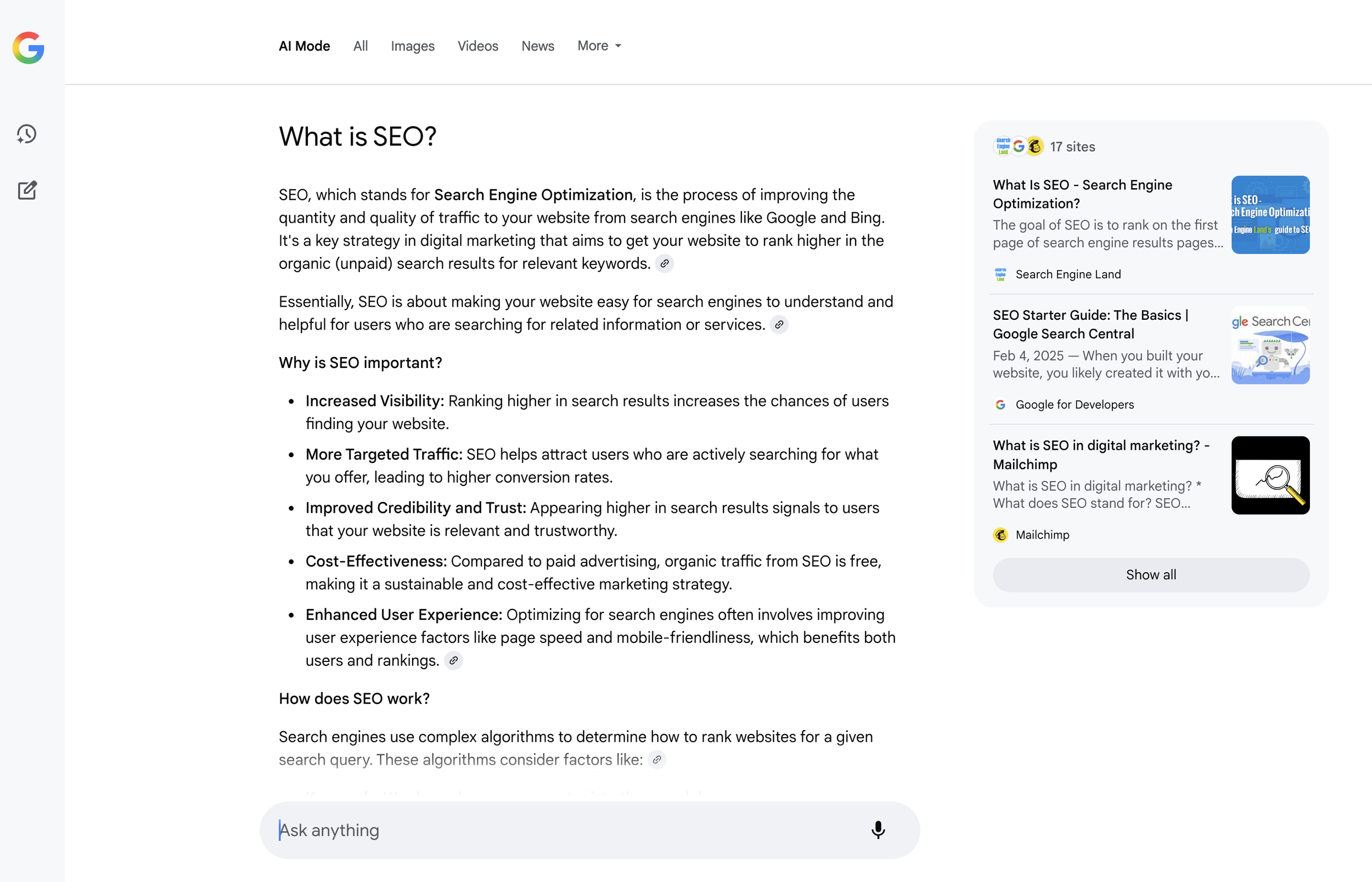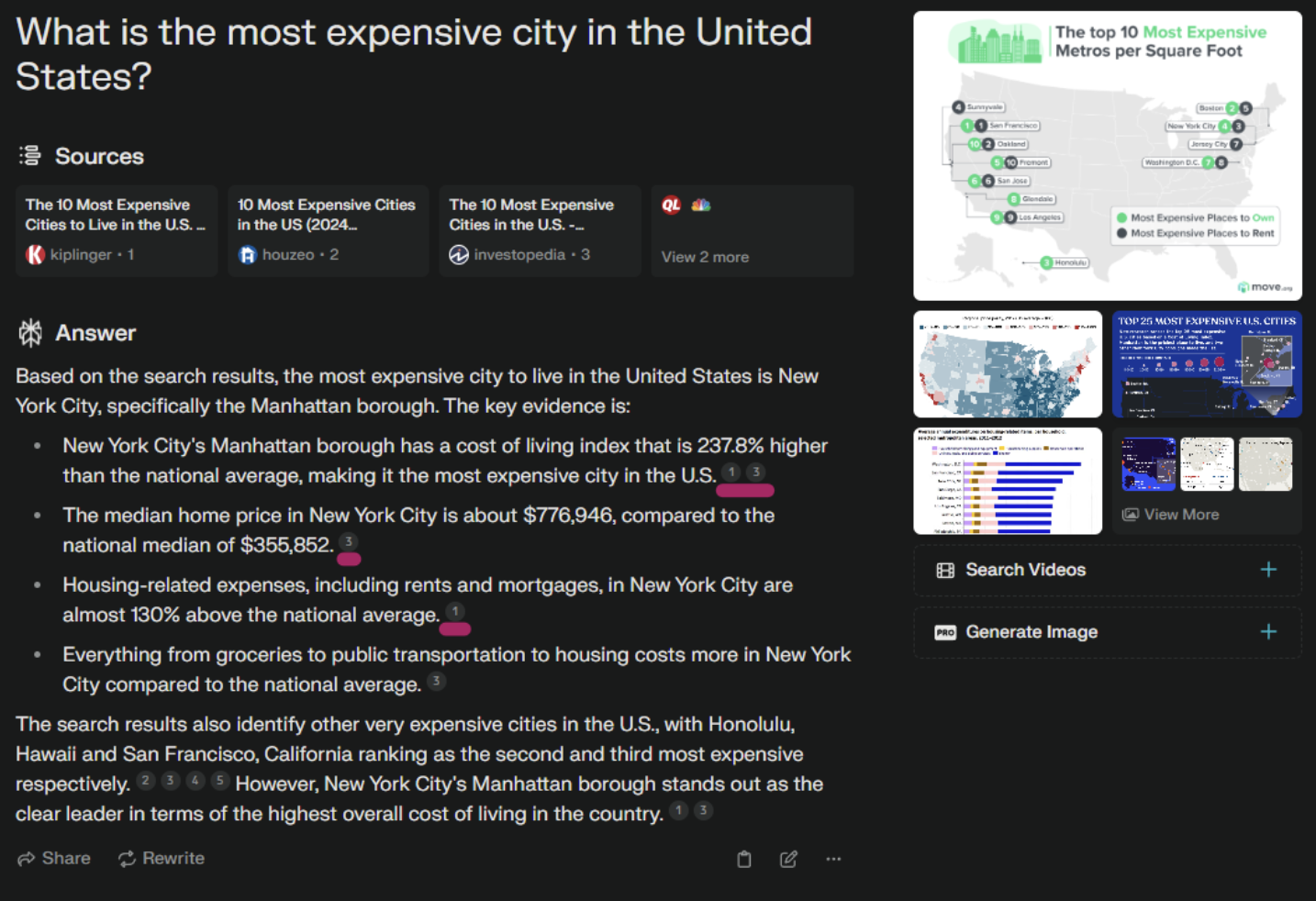Google AI Mode: What It Means for Search and SEO
Google recently introduced AI mode, which is changing how results show up and how we write for them. This next step in Google’s Search Generative Experience (SGE) is designed to answer questions more organically using live, relevant web content. This feature prioritizes helpful, accurate sources and uses conversational responses to better reflect how people actually search online.
What is Google’s AI Mode?
Google’s AI mode is shifting Search to work more like a conversation than a list of links. The idea is to create more natural and detailed answers.
How it Works with Google Search
Retrieval-augmented generation (RAG) is a technique that allows Bard and Bing to access live content on the web to improve the quality of their responses. If you have high-quality, relevant product content on your site, the model may use it. If, on the other hand, the LLM judges your content to be inaccurate, inconsistent, or overly biased, it can exclude it from the results.
This approach fits with Google’s bigger goal: to give people answers, not just results that match keywords.
How Does Google AI Mode Work?
Google’s AI Mode takes your search and expands it into several related searches. It then scans up to 100 sites to create a detailed summary with citations. This functionality is called query fan out.
Key Features and Layout
AI Mode shows a large answer box at the top of the page. It gives you a complete response with buttons to ask more or dig deeper. You’ll also see previews of the sources it used. This way, you can click and learn more.
How do you get Google AI in Search?
Google AI Mode is being rolled out gradually. To access it, users must opt into Google Search Labs and enable the AI-powered search experience.
How AI Mode Will Change SEO Landscape
Search is shifting rapidly. With AI Mode, it’s not only about keywords anymore. It’s also about how well your content answers the question behind the search.
Shift From Keywords to Context
Google is looking for helpful answers, not exact keyword matches. That means your content should focus on the intent behind the search (i.e., what someone really wants to know). Your writing will appear more regularly when you write in a conversational style and cover questions clearly.
The Rise of Semantic Search
AI Mode understands different ways people ask the same questions. So, your content needs to include related terms, synonyms, and a complete view of the topic. Google’s models use older training data and live info to comprehend meaning, not just match phrases.
Take Perplexity.ai, for example. Many answers you receive have numbers to support their claims. Perplexity will link to you if you can provide the data they’re looking for.
Related Article: The Evolution of Search: How LLMs Are Changing SEO
If you’re managing website content in an AI-driven search world, review our tips on how to make your site LLM-friendly. From schema markup to simplified design, these strategies help keep your content visible and relevant as search continues to change.
Content Quality and Relevance
Want to appear in AI Mode? Your content needs to be clear, trustworthy, and complete. That means writing in a way people understand, using formatting that’s easy to follow, and including details that answer questions fully. Be as specific and descriptive as possible, explaining what makes your product unique and highlighting the context of its use along with its UVP.
SGE enables users to ask questions more conversationally; therefore, you should incorporate conversational language and address common questions in your content. Content should directly answer questions concisely, as this can increase the likelihood of appearing in featured snippets, SGE answer boxes, and PAA.
Also, add schema and source links to support your info.
“SEO Best Practices & LLM (Large Language Model) Optimization Best Practices are like siblings to one another. There’s a lot of overlap, and the good news is you don’t need to overhaul your strategy to support both. With just a few smart adjustments, your content can rank well and align with how AI understands and delivers results.”
Lawson Robinson, Eyeful Media Sr Manager SEO
What These Changes Mean for Businesses
AI Mode is changing how search works. That means businesses need to adjust how they show up online. SEO now requires more than just good keywords. You’ll need to use schema, write in a question-answer format, and focus on content that’s helpful and simple to understand. It’s also essential to show actual knowledge and experience in your space. These updates make search more competitive, but they open the door for businesses that are also ready to adapt.
Common schema types that should be mandatory (where applicable):
Also, the FAQ can include warranty information, instructions on how to take care of a product, and more. Most users will rely on an AI chatbot to answer their questions, which indicates a need to provide question-and-answer format content.
You’ll also want to provide multi-media assets on product and editorial pages, including images, videos, and infographics. Prioritize utilizing a diverse range of assets. The goal is to inform the LLM as much as possible so it understands everything about your products. Include relevant keywords, alt text, file names, and captions.
Where appropriate, provide statistical data and graphs. This helps establish credibility and indicates that numbers back up the information we provide.
Related Article: How to Integrate Paid and Organic Search Marketing Campaigns to Maximize ROI
If you’re managing both paid and organic search campaigns, review our tips on aligning SEO and PPC for better performance. From keyword testing to shared analytics, this approach boosts visibility and improves ROI across both channels.
Best Practices for Adapting SEO to AI Optimizations: How We Got Ahead of the Curve
We started seeing the shift toward AI-driven search early on. Watching new tools roll out and testing updates in real time enabled us to build strategies that match how AI understands and ranks content today.
When We Saw the Shift Coming
We noticed the change when ChatGPT launched and Google started testing SGE. We also noticed that Bing added AI features and that Bard started pulling live web content. Internally, we had team discussions about how AI would impact rankings and what we needed to do to stay ahead.
How We Adapted Our Strategy
We built new content templates that made pages easier for AI to process. We focused on question-answer formats, adding schema, and using images and data when it made sense. We also ran tests to see what worked best and kept updating our approach as tools like Bard and Gemini advanced. Our goal was to match how AI pulls and shows content, not just how search used to work.
Our Top SEO Recommendations
Prioritize Google E-E-A-T
SGE prioritizes high-quality, authoritative content from credible sources. Enhance client websites by showcasing author expertise, citing credible references, and building a solid reputation.
To help search engines (and users) trust your site:
Show who’s behind the content. Include author names, bios, and credentials on articles or blog posts.
Create strong About pages. These should include your brand’s mission, values, history, team bios, awards, press mentions, and contact info.
Be transparent. Share details about your editorial policies, fact-checking process, and how you handle corrections.
Link to real people. When possible, add links to authors’ social profiles or contributor pages to confirm they’re credible sources.
Websites that clearly show who they are and why they’re reliable are more likely to earn better placement in AI-powered search results. Search engines want to feature sources that demonstrate real-world expertise and trust.
High-Quality Product Descriptions
Present product copy to chatbots in the same way you would to shoppers. Here are four tips:
Provide an accurate, complete, and clear product description.
Use conversational language, as that is how most users interact with their AI chat tool.
Answer common questions in the same way you would an FAQ.
Be as specific and descriptive as possible, explaining what makes this product good/unique and highlighting the context of its use along with its UVP.
Optimize for Conversational Queries
SGE enables users to ask questions more conversationally. In response, we should incorporate conversational language and address common questions in our content. Content should directly and concisely answer questions to increase the likelihood of appearing in featured snippets, SGE answer boxes, and PAA.
Google’s AI Modegle/products/search/ai-mode-search/ also uses “query fan-out” to break a user’s question into smaller parts and pull answers from multiple sources. Structuring your content to cover related sub-questions can boost your chances of being included in those AI-generated summaries.
Leverage Multi-Media Content
Provide multi-media assets on product and editorial pages, including images, videos, and infographics. Prioritize utilizing a diverse range of assets. The goal is to inform the LLM as much as possible so it understands everything about your products. Include relevant keywords, alt text, file names, and captions.
Where appropriate, provide statistical data and graphs. Doing so builds credibility and shows how numbers back up the information we provide.
Let’s look at Perplexity.ai as an example. Many answers you receive have numbers to support their claims. Perplexity will link to you if you can provide the data they’re looking for.
Improve Topical Authority
Build topical authority and internal links to help establish clients as an authoritative hub on specific topics.
Develop a content strategy that includes content clustering (covering all relevant topics and subtopics within the client’s niche). This, in turn, will improve the site’s internal linking structure and help search engines better understand the relationship between pages.
Metadata/Tags
Focus tags on providing additional context, including intended audience, secondary use cases, and product features.
Why Did Google Introduce AI Mode?
People already ask questions in a casual way, and Google built AI Mode to match that. It also helps surface content that’s detailed, transparent, and trustworthy. That means better answers for users and more value for strong content.
Related Article: 5 Key Takeaways from Google Marketing Live 2025
If you’re running paid campaigns on Google, review our breakdown of the top takeaways from Google Marketing Live 2025. From AI-powered search to smarter measurement tools, these updates help you refine your strategy and stay competitive.
Is Bard AI better than ChatGPT?
Google introduced Bard, and now Gemini, to compete with ChatGPT. Both tools are powered by large language models and give conversational answers. ChatGPT has been widely adopted, but Google aims to stand out by connecting Bard and Gemini directly to Search, using real-time web data (RAG), and improving how results are shown through AI Mode.
Also, SGE prioritizes high-quality, authoritative content from credible sources. Enhance client websites by showcasing author expertise, citing credible references, and building a solid reputation.
Adapting to the Future of Search
As Google leans into AI-powered results, the rules of SEO are changing fast. The sites that succeed will be the ones that focus on clarity, trust, and real value for users. By adapting your content now—using strong structure, conversational language, and expert-backed info—you’ll stay visible no matter how search evolves.
Worried about what Google’s AI Overviews mean for your brand’s visibility? You’re not alone—and you’re right to be paying attention. In this new era of search, where AI is reshaping what users see (and click), it’s critical to have a SEO and AI Search partner who understands how to adapt.
Eyeful’s AI/GEO Readiness Audit helps you understand exactly how prepared your site is for this next wave of discovery and where the gaps are that could cost you visibility
Eyeful Media helps brands stay ahead of these seismic changes, aligning SEO and content strategies with how Google really works today. Let’s future-proof your visibility—reach out to us to build a smarter search strategy for 2025 and beyond.


